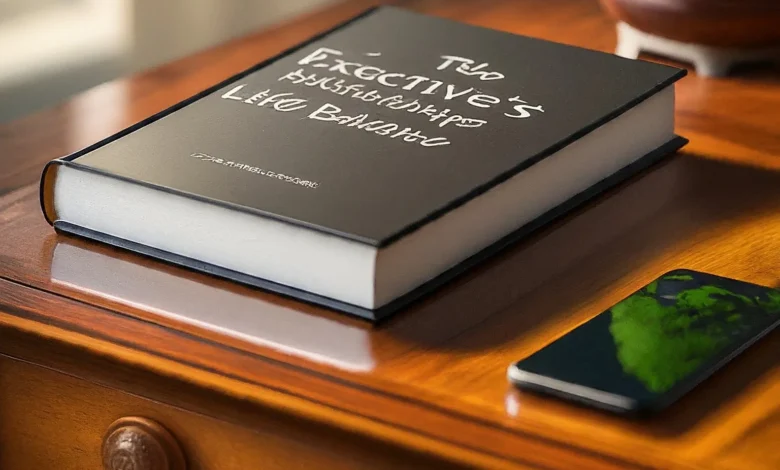The Executive’s Toolkit for Mindful Leadership and Life Balance

Imagine a world where executives effortlessly juggle their professional responsibilities while maintaining a fulfilling personal life. Sounds too good to be true? Well, it’s not as far-fetched as you might think!
In today’s fast-paced business world, executives face a constant barrage of challenges that can leave them feeling overwhelmed and out of balance. But what if there was a way to navigate these choppy waters with grace and ease?
Enter the concept of mindful leadership – a game-changer for executives seeking to excel in their careers while nurturing their well-being. In this post, we’ll unveil a powerful toolkit designed to help you master the art of mindful leadership and achieve that elusive work-life balance. Get ready to discover practical strategies that will transform your approach to leadership and life!
Understanding Mindful Leadership
Mindful leadership is a powerful approach to management. It combines awareness, focus, and empathy. This style of leadership helps executives stay present in the moment.
Benefits of mindful leadership include:
- Improved decision-making
- Enhanced stress management
- Better team communication
- Increased emotional intelligence
- Higher productivity
Mindfulness contributes to better decision-making by reducing distractions. It allows leaders to focus on what’s truly important. This leads to more thoughtful and effective choices.
Stress management improves significantly with mindful practices. Leaders learn to respond to challenges calmly. They avoid knee-jerk reactions that often worsen situations.
Research shows that mindful leaders create more positive work environments. They foster creativity and innovation in their teams. This results in higher employee satisfaction and retention.
The Executive’s Mindfulness Toolkit
1. Meditation Techniques for Busy Executives
Meditation is a key tool for mindful leadership. It can fit into even the busiest schedules.
Here are some quick meditation exercises for the office:
- One-Minute Breathing: Focus on your breath for just 60 seconds.
- Body Scan: Spend 2-3 minutes noticing sensations in your body.
- Mindful Observation: Choose an object and observe it closely for 1 minute.
Mindfulness apps can help executives maintain a consistent practice:
- Headspace
- Calm
- Insight Timer
Incorporating meditation into daily routines:
- Start your day with a 5-minute meditation.
- Use lunch breaks for a quick mindfulness session.
- End your workday with a brief calming exercise.
These practices can significantly improve focus and reduce stress.
2. Stress Management Strategies
Stress is a common challenge for executives. Managing it effectively is crucial for success.
Identifying stress triggers in the workplace:
- Tight deadlines
- Conflict with colleagues
- High-stakes decisions
- Information overload
Techniques for immediate stress relief:
- Deep breathing exercises
- Quick stretching at your desk
- Mindful walking during breaks
Long-term stress reduction practices:
- Regular exercise
- Adequate sleep
- Healthy eating habits
- Hobbies outside of work
Here’s a comparison of short-term vs. long-term stress management strategies:
| Short-Term Strategies | Long-Term Strategies |
|---|---|
| Deep breathing | Regular exercise |
| Mindful breaks | Improved sleep habits |
| Stretching | Balanced nutrition |
| Positive self-talk | Cultivating hobbies |
Implementing both types of strategies can lead to better overall stress management.
3. Time Management and Prioritization
Effective time management is crucial for executives. It helps maintain focus on important tasks. The Eisenhower Matrix is a valuable tool for prioritization.
Here’s how the Eisenhower Matrix works:
- Urgent and Important: Do these tasks immediately.
- Important but Not Urgent: Schedule these for later.
- Urgent but Not Important: Delegate these tasks if possible.
- Neither Urgent nor Important: Eliminate these tasks.
Time-blocking is another useful technique. It involves assigning specific time slots to tasks. This method helps increase productivity. It also reduces the tendency to multitask.
Here’s how to implement time-blocking:
- Start your day by reviewing your to-do list.
- Assign each task a specific time slot.
- Focus solely on the assigned task during that time.
- Take short breaks between blocks to recharge.
Effective delegation is also key to time management. It allows executives to focus on high-priority tasks. Here are some tips for delegating:
- Identify tasks that can be handled by others.
- Choose the right person for each task.
- Provide clear instructions and expectations.
- Follow up and provide feedback.
By combining these strategies, executives can significantly improve their time management. This leads to increased productivity and reduced stress.
4. Emotional Intelligence in Leadership
Emotional intelligence is crucial for effective leadership. It involves understanding and managing emotions. This skill helps executives navigate complex workplace dynamics.
Understanding your own emotions is the first step. It requires self-awareness. Pay attention to your feelings throughout the day. Notice what triggers certain emotions. This awareness helps you respond more effectively to challenges.
Managing your emotions comes next. It’s about controlling your reactions. Take a deep breath before responding to stressful situations. Practice mindfulness to stay calm under pressure. These techniques help maintain composure in difficult times.
Recognizing others’ emotions is equally important. Watch for non-verbal cues in your team members. Listen actively to understand their concerns. This skill helps build stronger relationships with your team.
Responding to others’ emotions requires empathy. Put yourself in their shoes. Acknowledge their feelings. Offer support when needed. This approach fosters a positive work environment.
Developing empathy in the workplace has many benefits. It improves team collaboration. It reduces conflicts. It also increases employee satisfaction and retention.
Key emotional intelligence skills for executives include:
- Self-awareness
- Self-regulation
- Motivation
- Empathy
- Social skills
Developing these skills can significantly enhance your leadership effectiveness.
5. Work-Life Integration Techniques
Work-life balance is crucial for executive well-being. It’s about integrating professional and personal life effectively. Here are some key techniques:
Setting boundaries is essential. Define clear work hours. Stick to them as much as possible. Avoid checking work emails during personal time. Communicate these boundaries to your team.
Flexible work arrangements can help. Consider options like remote work days. Implement flexible start and end times. This flexibility can reduce stress and increase productivity.
Regular breaks are important. Take short breaks throughout the workday. Use this time to relax and recharge. Step away from your desk for lunch. It helps maintain focus and energy.
Vacations are not a luxury; they’re a necessity. Plan regular time off. Disconnect completely during vacations. It helps prevent burnout and improves overall well-being.
Tips for effective work-life integration:
- Create a dedicated workspace at home
- Use technology to streamline tasks
- Practice saying “no” to non-essential commitments
- Schedule personal activities as you would work meetings
- Develop a consistent sleep schedule
- Engage in hobbies and interests outside of work
Remember, work-life integration is an ongoing process. It requires regular assessment and adjustment.
6. Physical Well-being for Optimal Performance
Physical health directly impacts executive performance. It’s crucial for maintaining energy and focus. Here’s how to prioritize your well-being:
Regular exercise is vital for executives. It boosts energy levels. It improves cognitive function. Aim for at least 150 minutes of moderate exercise weekly. This could include brisk walking, cycling, or swimming.
Nutrition plays a key role in maintaining energy. Eat balanced meals throughout the day. Include plenty of fruits and vegetables. Choose whole grains over refined carbs. Stay hydrated by drinking water regularly.
Sleep hygiene is essential for recovery. Aim for 7-9 hours of sleep nightly. Establish a consistent sleep schedule. Create a relaxing bedtime routine. Avoid screens an hour before bed.
Here’s a simple weekly wellness plan template:
Monday: 30-minute jog, Meal prep for the week
Tuesday: 15-minute desk stretches, Meditation before bed
Wednesday: Yoga class, Early bedtime
Thursday: 30-minute strength training, Healthy lunch with colleagues
Friday: 20-minute walk during lunch break, Tech-free evening
Saturday: Longer workout session, Prepare healthy meals for the weekend
Sunday: Active rest day (light walk), Plan for the week ahead
Remember, small, consistent steps lead to significant improvements in physical well-being.
7. Mindful Communication Practices
Mindful communication is crucial for effective leadership. It enhances understanding and reduces conflicts. Here are key practices to implement:
Active listening is a fundamental skill. Give your full attention to the speaker. Avoid interrupting or planning your response. Focus on understanding their perspective. This shows respect and builds trust.
Non-violent communication helps in high-stress situations. Express observations without judgment. State your feelings and needs clearly. Make specific requests instead of demands. This approach reduces tension and promotes cooperation.
Mindful email habits can improve digital communication. Take a moment before sending important emails. Review the content and tone. Consider the recipient’s perspective. This can prevent misunderstandings and conflicts.
Examples of mindful vs. non-mindful communication:
Mindful: “I noticed the report was submitted late. Can we discuss any challenges you’re facing?”
Non-mindful: “You’re always late with your reports. You need to be more responsible.”
Mindful: “I feel concerned when deadlines are missed. How can we work together to meet them?”
Non-mindful: “Your missed deadlines are stressing me out. You need to do better.”
Mindful: “Could you please provide an update on the project by Friday?”
Non-mindful: “I need that update now. Why haven’t you sent it yet?”
Practicing these communication techniques can significantly improve workplace relationships and productivity.
Implementing the Mindful Leadership Toolkit
Adopting mindful leadership practices takes time and effort. Here’s how to incorporate these tools into your daily life:
Start small. Choose one or two techniques to focus on initially. This prevents overwhelm. It allows for gradual, sustainable change.
Create a routine. Set specific times for mindfulness practices. This could be a morning meditation or an afternoon walk. Consistency is key to forming new habits.
Use reminders. Set phone alerts for mindfulness breaks. Place sticky notes in your workspace. These visual cues help maintain focus on your goals.
Track your progress. Keep a journal of your mindfulness journey. Note improvements in stress levels and productivity. This motivates continued practice.
Common obstacles in adopting mindful practices include:
- Lack of time
- Difficulty focusing
- Skepticism about benefits
- Inconsistent practice
To overcome these:
- Schedule mindfulness activities like any other important task.
- Start with short, guided sessions to improve focus.
- Educate yourself on the scientific benefits of mindfulness.
- Be patient and persistent. Results come with time.
Measuring impact is important. Look for improvements in:
- Decision-making quality
- Stress levels
- Team communication
- Work satisfaction
- Overall well-being
Remember, the journey to mindful leadership is ongoing. Be kind to yourself as you progress.
Conclusion
Mindful leadership is a powerful tool for executives. It enhances both personal well-being and professional success. Let’s recap the key components of our executive mindfulness toolkit:
- Meditation techniques for busy schedules
- Effective stress management strategies
- Time management and prioritization skills
- Emotional intelligence in leadership
- Work-life integration techniques
- Physical well-being practices
- Mindful communication skills
Remember, the journey to mindful leadership is a marathon, not a sprint. Start small and build consistent habits. Even minor changes can lead to significant improvements over time.
The long-term benefits of mindful leadership are substantial. They include:
- Improved decision-making abilities
- Enhanced stress resilience
- Better team relationships
- Increased personal satisfaction
- Greater organizational success
By implementing these tools, you’re not just improving your own life. You’re creating a positive ripple effect throughout your organization.
Take the first step today. Choose one technique from the toolkit to practice this week. Your future self will thank you for starting this transformative journey.
Remember, mindful leadership isn’t about perfection. It’s about progress and continuous growth.



